How Augmented Reality and Virtual Reality are Evolving Advertising Strategies Today

Picture it, it’s 1994. Ace of Base’s “The Sign” was topping the charts, Disney’s The Lion King was the highest grossing film and on the cover of Time Magazine was the next big thing — the internet. It was also the year a little rectangle was purchased on HotWired.com by AT&T, the very first banner ad, which 44% of people who saw it clicked.

This ad was part of AT&T’s “You Will” campaign which included a series of television commercials featuring predicted scenes from an internet-enabled future — many of which are common scenes you’ll find today. The ad set off a chain reaction that altered the course of the advertising industry.
https://medium.com/media/97c7ca39c4a8e44dd55151cf953f62b3/hrefFast forward to 2020, where the advertising industry is being presented with another explosive technology which has the potential to disrupt advertising just as much, if not more, than the birth of the internet.
Like the banner ad, advertisers are being equipped with a new medium which will allow them to reach, engage, and connect with people in ways we haven’t been able to do with today’s offline and online formats. This is because this next wave of computing offers users something more than just reading, watching, viewing, clicking, and sharing. It offers them something they can experience. And it comes at just the right time as advertisers are beginning to figure out how to succeed in the growing experience economy.

But what do I mean when I talk about AR and VR? Well for those of you who are new to these technologies, welcome! Let me give you a 1-min crash course.
At its core, this next wave of computing is all about senses. On one hand we are giving computers senses so that it can understand the world around it. On the other, the computer uses its new understanding to change the way we perceive the world. In the case of AR, we perceive an augmented version of our world, one edited by computers such as adding digital information or objects to our scene. In the case of VR, we perceive a completely simulated world instead of our own — thus a “virtual” reality.
To enable this new way of perceiving, devices are required — either those we hold or those we wear. And these devices, for the most part, have active sensors like a camera and a screen that we look at or through.
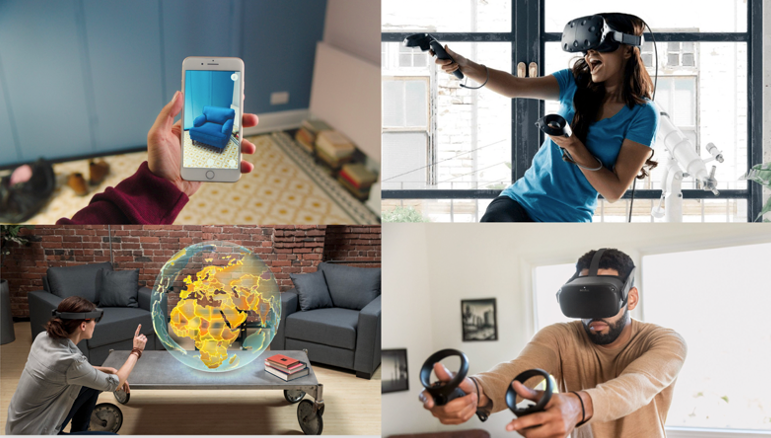
As VR requires this world to be occluded, the user must wear a head-mounted display to engage in this type of immersive experience. VR devices are either tethered to a PC such as HTC Vive or Oculus Rift or standalone units like Oculus Quest, the latter of which has dramatically increased the market size of VR in the mainstream.
With AR the device landscape is more varied — but the majority of AR experiences fall under 2 device categories. AR can be facilitated with a handheld device like a tablet or smartphone — something very important to note seeing there are nearly 3 Billion smartphones that can enable an AR experience today. AR can also be facilitated by a headworn device or what is often called “smart glasses” such as Nreal Light, Microsoft HoloLens and Magic Leap One — all of which are available today but have a long journey for consumer adoption.
For both AR and VR, experiences can be created and accessed by a user either as a native application or as a browser-based experience — the latter of which is often referred to as WebAR and WebVR.
Advertisers have always been early adopters of tech, and AR and VR are no exception. Countless agencies and brands are already leveraging AR and VR to realize ROI and ramp up their teams on the skills and mindset needed to succeed within this next wave of computing. An important takeaway here is that AR and VR are not tomorrow technologies but rather technologies in play today.
The following illustrates how AR and VR is already evolving the advertising industry.
The Evolution of Display Ads
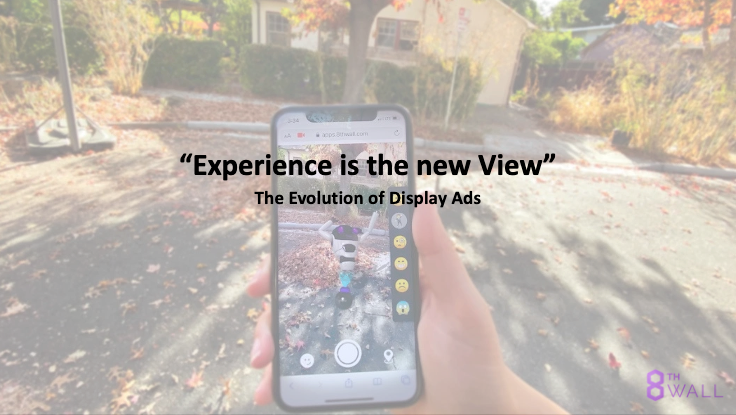
Analysts expect global augmented reality ad market spend to reach $2.6 billion by 2022. Ad networks are embracing AR as a new and powerful ad format — including those which run in apps such as Snapchat, Facebook, Unity and more and with the power of WebAR, any banner ad can be connected to an AR experience.
AR is evolving digital ads well past clicks and views towards interactivity and engagement. AR ads give your users the opportunity to interact with product, IP and brand elements in a way that is just not possible with 2D digital content including video. This moves ads from being something you read, watch or listen to– to something you experience.’
Today’s AR ads also give you the reach needed to justify the spend as they leverage devices that users already have access to such as their smartphone
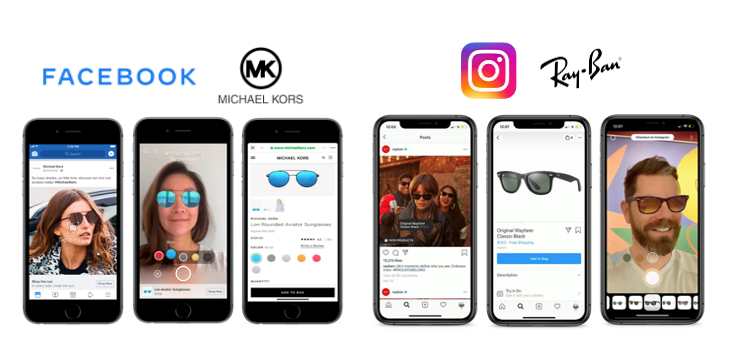
Many of you may have most likely used and maybe even have created an AR ad already utilizing platforms like Snapchat or Facebook.
Just this month, Snap debuted its Lens Builder to make the creation of AR ad formats more accessible and to reduce the friction of buying and producing AR ads. Utilizing this tool, advertisers can bid programmatically for distribution of AR ads.
Facebook has also demonstrated its commitment to rolling out 3D and AR ads in the News Feed. It has piloted with Michael Kors which used AR to let consumers try on sunglasses. Facebook had previously tested AR ads in Messenger with a variety of brands such as ASUS which saw 10 times the engagement with their AR experience, Nike selling out of the Kyrie 4s shoe in under an hour and Kia increasing engagement with its dealers.
Facebook is also slowly rolling out AR try-on features to product pages in Instagram. Initially, the new AR feature will be limited to cosmetics (Mac and Nars are early partners) and eyewear brands (Warby Parker and Ray-Ban), but Instagram plans to make it available for more products over time.
Virtual-try is a major use case for e-commerce and AR ads and as such it is also something that Google is focusing on. After launching an alpha last year, YouTube is expanding the availability of its AR Beauty Try-On feature. Moving forward, you’ll be able to virtually try on lipstick from brands like MAC and NARS by tapping on ads in the YouTube app.
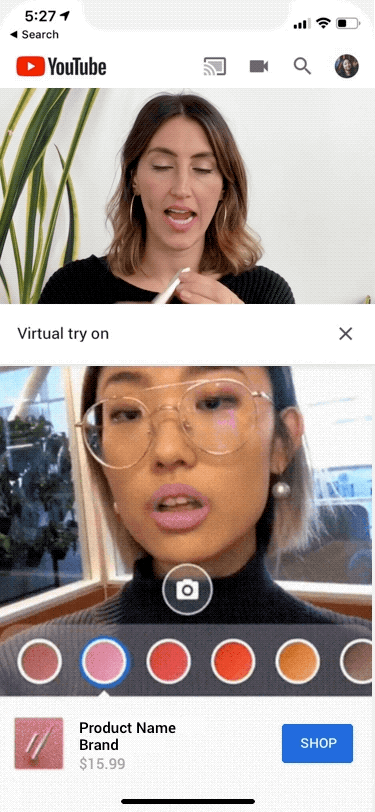
Visualizing product, however, is not limited to products that can be put on your face like sunglasses, hats, and other accessories. AR can place a number of products into your environment for you to visualize and try out before you buy by utilizing the rear-facing camera on your smartphone.
In this WebAR example created by Hoopla Digital, Bailey’s UK leveraged 8th Wall’s world tracking capabilities to let users design and pour their perfect glass of Baileys for the holidays right in front of them.
https://medium.com/media/78b0801292e1c40689d0f01e370f544c/hrefHere users were asked to select their glass, the Baileys of their choice and a topping and then take a picture of their perfect drink to get inspired to make it IRL for the holidays.
But AR campaigns don’t need to be just about product, but can also bring IP and brands to life to give users a chance to be part of the story. Amazon, Sony Pictures and Trigger teamed up to run a WebAR campaign for Jumanji: The Next Level.
https://medium.com/media/6b16086a9e5d9bfed9ca3ef93d29f45b/hrefThis world AR experience was the first to integrate Amazon Lex voice services which let the user’s use their voice to travel the Jumanji map, jumping into the action including running with the ostriches, and watching bonus material related to the movie and of course to buy movie tickets.
As WebAR experiences can be accessed by a URL or a QR code (again no app required), this campaign was distributed via web and mobile ads including page takeovers and posts on the brands social account.
https://medium.com/media/77f034ea6f6d8635ac1816c902ad63af/hrefDraw and Code used the 8th Wall platform to create a whimsical WebAR campaign for Sony Legacy’s Pink Floyd: The Later Years which could be accessed via a link distributed on social or found as a destination to an ad. Users were able to swipe through the various tracks found on this greatest hits collection each of which was paired with an augmented reality experience which brought the art of this iconic band to life.
The WebAR experience was launched during the Christmas holidays where Draw & Code reported tens of thousands of users across nearly 140 countries tried the experience during the first week alone with an average engagement time of around two minutes.
The Evolution of Out-of-Home
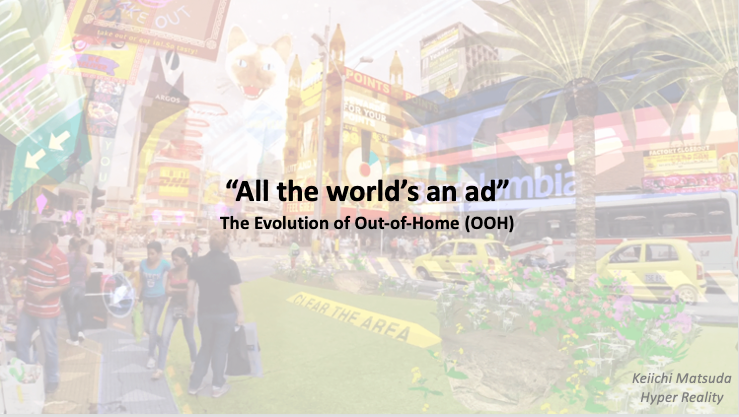
Worldwide ad spending on outdoor or out of home will grow to $40.6 billion this year. While billboards, transit shelters and other signage provides an opportunity to reach a wide audience it lacks the engagement and measurement capabilities its digital ad counterparts bring to the table.
But AR is changing this.
My good friend and previous partner at Super Ventures Ori Inbar once said: Where the Web Economy was defined by “clicks on links”. The AR or spatial economy will be defined by “clicks on bricks”. And it’s true. With AR the whole world becomes an ad opportunity! And in this way, AR and VR expands the benefits of digital advertising to out-of-home.
AR can bring posters, signage and billboards to life. Trainline, a UK platform for finding and booking train tickets, installed a series of 16 WebAR-activated posters around Waterloo Station which transformed into live departure boards when viewed through a smartphone. Produced by digital agency Byte, the AR timetables also revealed a comparison of CO₂ emissions generated by each journey when traveled by a car versus train.
https://medium.com/media/234b4cceeaca7676147127823687be49/hrefAR can also bring street art to life. An 8,000 sqft. mural was featuring Kawhi Leonard was created in eyesight of the Staple Center in collaboration between BaltiVirtual and Muros for the LA Clippers. To create further hype for the team’s season opener, they added an additional layer of engagement with Augmented Reality using Snapchat’s Lens Studio.By scanning a Snap code, users were able to see Kawhi bust through the wall and make an incredible 3-point shot!
https://medium.com/media/d245dad1e51552f1ca771195b8ac317f/hrefTransit ads and even transit cards can be made interactive with AR and be used to drive traffic to a store. To promote its newest line of sneakers adidas wrapped streetcars in Toronto with “Boost My Ride” messaging. Once passengers stepped on board, ads within the streetcar invited them to scan a QR code to turn their transit pass into a scratch card and they could then tap to “scratch” in order to reveal if they won a prize. Winners could then hop off the streetcar at adidas’ flagship store in Toronto to claim their prize. This activation was created by interactive agency Jam3 and was part of a campaign that extended from outdoor to social media, to the flagship store itself.
https://medium.com/media/b6d5a629246b363b140859efd143e358/hrefWhile AR can bring billboards, murals and transit ads to life, it actually doesn’t need a physical ad at all — it can transform an entire building completely on its own.
Snapchat’s Landmarker Templates turn select buildings themselves into an AR experience including the Eiffel Tower, TCL Chinese Theater and Buckingham Palace. The Landmarker Template allows you to create unique Lens experiences at selected locations utilizing Landmarker tracking to create a 3D experience that is tightly tracked to the location’s architecture.
https://medium.com/media/4d1c0eb1ced94e7d9e60d1897ba5c397/hrefIn April of last year, Snap teamed up with HBO’s Game of Thrones to turn NYC’s iconic flatiron building into the perch for one of Khalessi’s dragons for a limited time.
But AR can go beyond just a single destination, turning an entire city or series of cities into an engaging campaign. In October of last year, Ally turned six American cities into a giant MONOPOLY board game. The WebAR game gave users the chance to win up to $1 million in prizes.
https://medium.com/media/f68300c1795ee67fe0b802c5f9e0d813/hrefCreated by agencies Anomaly, MediaCom, Grammercy and m ss ng p eces, and powered by 8th Wall, the activation allowed users to quickly unlock the game by using a link or QR code which appeared on life-size game squares throughout cities like New York, and Chicago. By partnering with Hasbro, Ally managed to gamify financial literacy with everyone’s favorite board game.
Virtual worlds also have out-of-home opportunities with virtual billboards, transit shelters and signage real estate up for grabs to make VR environments feel more familiar and real.
https://medium.com/media/71e5ac126fd0265f8cebba503164b45b/hrefVR ad network startup Advrty teamed up with HatRabbit Entertainment and Coca-Cola to place virtual out of home Coke ads in the VR game Merry Snowballs. Advrty offers a new avenue of monetization for virtual reality developers, which doesn’t involve full field-of-view pop-up ads. Instead, it’s a platform which incorporates nonintrusive product or asset placement.
As VR adoption increases, and more and more of these worlds and experiences acquire a denser population, the advertising opportunity within them in turn becomes much more clear.
The Evolution of Print and Packaging
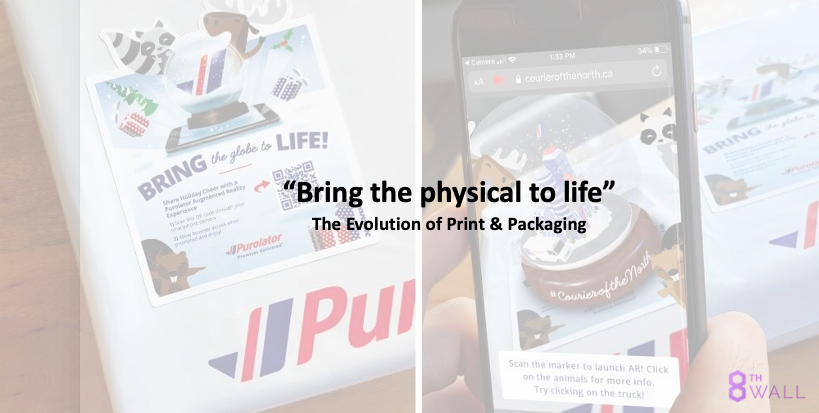
In 2019, an estimated $69 billion was spent on print ads and where my friend Ori believes that AR ushers in Clicks on Bricks, it also introduces “clicks on prints” turning mailers, cereal boxes and magazine ads into meaningful, interactive experiences that can be measured similarly to digital advertising.
One of the most effective uses of AR with print is its ability to detect and track 2D image files allowing you to bring static content to life. In the case of 8th Wall’s AR engine in particular, image tracking works in tandem with world tracking which gives developers the flexibility to design experiences that combine image targets and markerless tracking.
In addition, print and packaging are a great canvas to feature a QR code which users can scan to immediately access a WebAR experience.
https://medium.com/media/72b7a3f4462dad7632f3a1dba67c65e7/hrefCreated by EyeKandy, General Mills launched a campaign for a new brand of cereal called Fillows. Using WebAR image targets, Fillows took cereal box games to the next level by transforming their packaging into interactive puzzles with multiple levels and activities.
Making packaging interactive using AR can dramatically increase dwell time and engagement with a product which would otherwise only be looked at for product information.
https://medium.com/media/d2a281427531f517d559f192f713445d/hrefAugmented Reality and alcohol is actually a huge trend as spirit and wine brands use AR to bring their bottles to life. Wine and winemakers in particular often have a strong story to tell on their packaging as part of their marketing. With AR this story can be shown or told to the consumer.
Rabble Wine Company, producer of unconventional wines from California, launched their augmented reality app, which brings to life their historic wine labels. Rabble partnered with Tactic Studios in San Francisco for the production of the app.
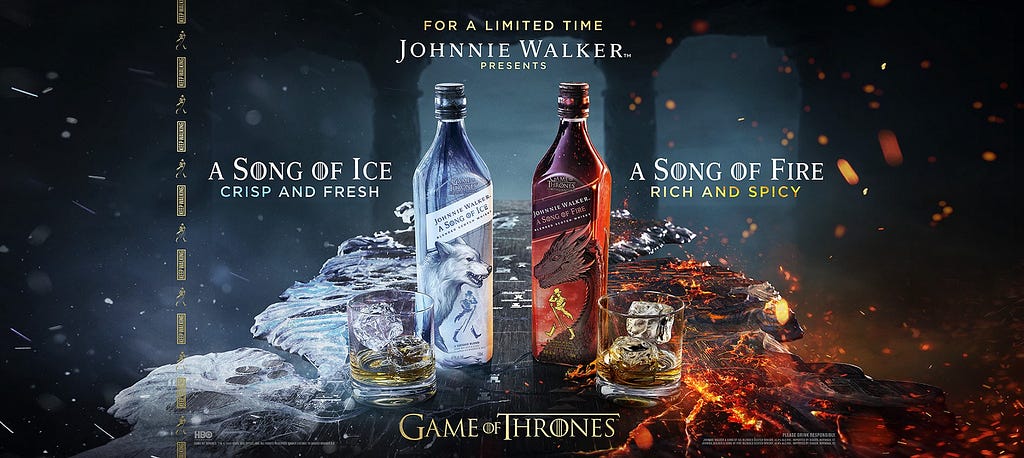
Keeping inline with AR’s spirited way to transform bottles is this WebAR experience for Johnnie Walker’s limited edition Scotch Whiskies which celebrated HBO’s series, Game of Thrones. Created by agencies AnalogFolk and Unit9 the bottles activated as image targets to reveal 3D characters from the show which burst to life out of the packaging. A Song of Ice is summoned the iconic Direwolf and A Song of Fire sparked a Dragon which made a smokey entrance.
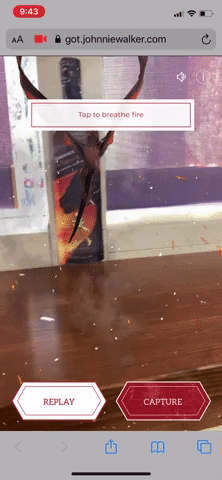
Toyota rolled out a fully integrated WebAR campaign in collaboration with Hearst Magazine’s Road & Track, bridging print and digital. The September 2019 issue included a custom double-sided poster featuring a red and yellow Supra along with a QR code to the WebAR campaign.
https://medium.com/media/7a1f128003c5d9b289d323dddeeed210/hrefOnce scanned, the QR code launched the AR experience allowing users to place the Supra on the table, or in their driveway or garage and customize it with the color of their choice. This same experience, developed by eXpanded eXistence, was also used as part of a digital ad campaign.
The Evolution of Influencer Marketing
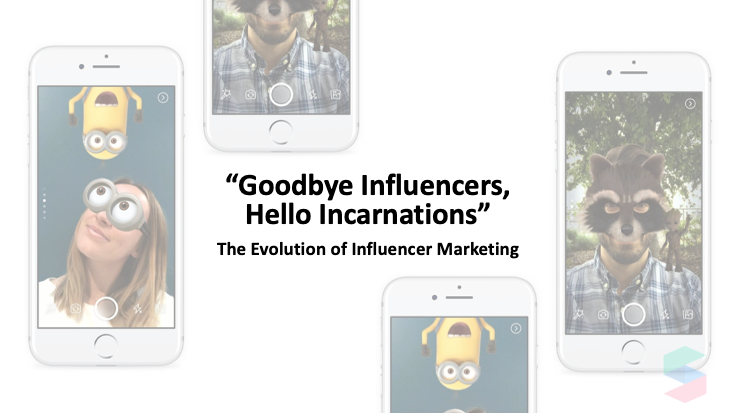
Social media has given rise to a new brand ambassador the influencer. 39% of Instagram accounts with over 15,000 followers are said to be active influencers and Influencer marketing is on track to be worth up to $15 billion by 2022.
It is clear that working with passionate individuals with a following is not going anywhere anytime soon. But there is something gunning for the influencer which could eventually take its place. Something that goes beyond an influencer organically incorporating your product or brand into their story videos or photo feed.
I call them the “Incarnations”.
Incarnations don’t use your brand or product, they embody or incarnate it. And they do this using Camera Effects and Avatars enabled by VR and AR.
https://medium.com/media/bd47efcfc985e9a8719918cdf4b9a1e3/hrefA great example of this was the use of Instagram Filters for Puma Singapore. Created by UltraSuperNew Singapore, #PUMANSOFSG was one of the first brand campaigns to use Instagram’s newly-launched AR face filters. The campaign included a Puma Face Filter which was used by a series of Singapore-based influencer. Not only did the influencers themselves become incarnations — embodying the Puma brand by becoming a part of its brand identity — literally wearing the face of a Puma but they also inspired their followers to use the filter themselves by sharing the link when they showed off the filter in their stories. This in turn created a population of PUMANS who would market the filter to their followers and so on.
The scale of influence, where the use of filters creates other users of the filter, is something unique to AR because the asset that your influencer is marketing is a digital one that can be shared and used throughout the network rather than a physical product that is captured and shared on one influencers feed relying on likes and comments.
Of course it would be amiss not to give a nod to the OG face filter platform Snapchat.
https://medium.com/media/b17af1c87c3e0dcb03f7ab12e0945324/hrefThis classic Lens from Taco Bell was used to celebrate Cinco De Mayo and it is one of the platforms most popular Lens to date and is a fantastic example of how AR can transform users into the brand.
Giving users the ability to embody a brand using AR is powerful as it allows the user to see themselves, literally, as part of your brand and in sharing this, it in turn lets their followers see them as the brand — thus increasing brand integrity and transferring the loyalty the followers have for the influencer to your brand.
https://medium.com/media/9a7f19b02b889f82b9e47ecc1546809d/hrefOn the Web, a face filter can make the user feel part of a WebAR experience which uses both the front and back facing camera by turning them into a character of the story. In partnership with Walmart, Sony Pictures launched a WebAR activation for the DVD release of Spider-Man: Far From Home. Produced by agency Ignite, the activation initially uses the front camera to apply a face filter to the user, then switches to the back camera where 3D drones appear.
And while the examples I have shown so far are mobile, there is a growing opportunity to tap into face filters being used on Desktop.
Snapchat’s Snap Camera is a desktop app which uses the webcam to bring select Snap Lenses to Zoom, Google Hangouts, Twitch and YouTube. Snap recently reported that Snap Camera has seen a surge in use, a 10-fold jump in downloads in fact, as more and more people are leveraging video conferencing solutions to stay connected while at home.
https://medium.com/media/af341c902a88033b00c194a59cfdb12b/hrefI expect that AR filters and virtual backgrounds will become a lucrative advertising opportunity moving forward as video conferencing continues to be in demand and as the new user behaviors being shaped today continue moving forward.
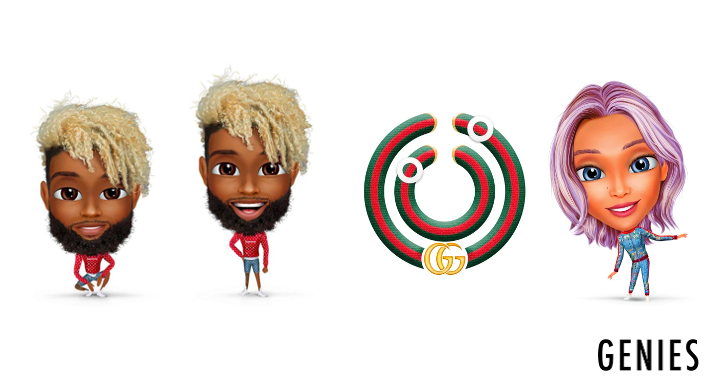
Users are not just using face filters to embody another character. Avatars have become a staple in our expression and users often have various digital twins on different platforms including Bitmoji, Memoji, Facemoji and Genies.
Avatars present a massive advertising opportunity, where branded assets can be used to dress up and shape the avatar choices for users. As is the case with a recent collaboration between Genies and Gucci where Genie avatar users can opt to strut in digital Gucci attire in their Instagram Stories, iMessage stickers and more.
https://medium.com/media/089beaa852e53fdfbfb8ce1212100e6b/hrefBut of course, it is in VR where avatars become wholly embodied. Just as we saw with Advrty, these virtual worlds are a growing ad opportunity as more and more users adopt this platform. A great place to see branded and non-branded avatars and get to know a new community of VR-only influencers is in VR Chat which is a community of 50,000 created worlds and growing.
The Evolution of Brand Identity
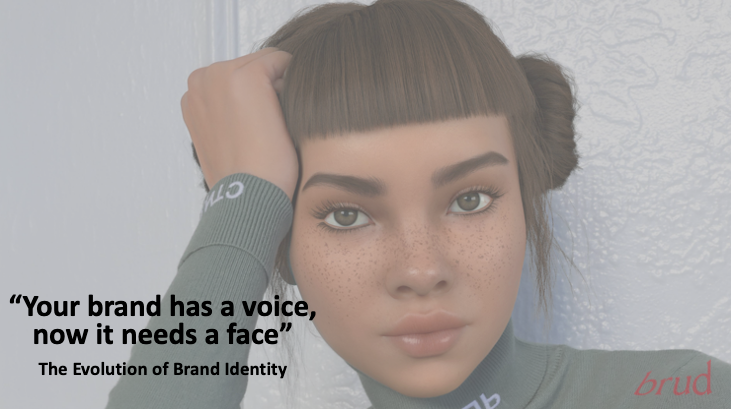
Brand identity is a crucial component to succeed in today’s world. How your brand is presented: from your logo and typeface to your tone, sits at the core of every marketing decision. In the 2D world — this translates to your website design and messaging, what content you post on your social page and the ideas and images of your advertising campaigns. But in the 3D world of AR and VR your brand needs to come to life, quite literally, requiring you to personify your brand identity. And to do this you will need a virtual being
https://medium.com/media/71c42dd83bea524a97ecf16c42a9eb2e/hrefMeet Jamie, ANZ’s new digital assistant created by Soul Machines, who is helping customers with some of their general banking queries. Jamie has a digital human face and persona, and is ‘brought to life’ using Soul Machines’ world-leading Human Computing Engine which combines neural networks and biologically inspired models of the human brain to allow her to express personality and character in an incredibly human-like way. She has been programmed to answer questions on 30 of the most frequently searched-for topics on the ANZ Help section of their website.
You may already be doing a lot of work using your brand identity especially tone in the creation of a chatbot for your brand. Chatbots are expected to power 85% of all customer service interactions by 2020 and result in a cost savings of $8B annually by 2022. And a recent study from Stanford found embodied assistants are trusted more by users which is just one reason why your chatbot requires a face as a virtual being. It becomes even more necessary in a world beyond the website with AR and VR.
Quantum Capture has a service called CTRL Human which can create virtual humans with the push of a button. Their workflow takes any high quality scan of a human or a net new digital one and brings it to life complete with face and body gestures and an AI back-end supporting most Chatbot services. They are currently working within banking, hospitality, healthcare, retail and real estate markets to give chatbots a face and body to better the experience.
https://medium.com/media/adcb7730cc1364ae2fd3caf4d176feef/hrefThe example above is a CTRL Human used in REinVR, a VR real estate solution, which shows how this 3D virtual human can be used in virtual reality. This same character can be used in AR, or on a 2D screen like a kiosk or even on your website
If there is a particular person you prefer to embody your brand, booking an appointment in a volumetric capture studio will be your thing. Volumetric Capture Studios record human performances from every perspective imaginable as a volumetric video. This video, especially when used in AR or VR, is often referred to as holographic video or simply holograms.
https://medium.com/media/8ddf107ce6b4598f101a7f452c489965/hrefThe examples in the video above are from Microsoft’s Mixed Reality Capture Studios of which Microsoft has their own capture stage in San Francisco and licensed partners in various parts of the world including Dimension Stage in the UK and Metastage in LA.
8th Wall has a partnership with Microsoft Mixed Reality Capture Studios to democratize holograms using WebAR — which means that users can access volumetric video with the click of a link, no app required. The example you are seeing in the video below is a WebAR experience created by Metastage featuring a hologram of Laura Rizzotto who is performing her entire single “One More Night” in my living room.
https://medium.com/media/79c6cd0fb81a31158be6ed70fe40d6c6/hrefGiving the user the ability to place a hologram in their own space dramatically increases the intimacy and connection a user can have with a spokesperson, celebrity or other volumetric actor you use as part of your campaign.
The Evolution of Experiential Marketing
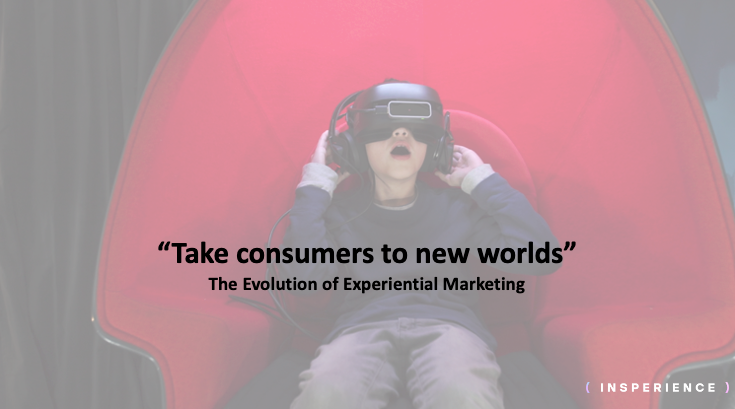
Effective marketing strategies typically attempt to evoke a feeling to align the user with the vibe of a product or brand and get them in the right frame of mind to convert to purchase. Experiential marketing is a compelling way to achieve this but creating a branded environment and experience can be costly and limited not just based on budget but on space and physics. AR’s ability to remix reality and VR’s ability to world build provide a brand new opportunity to create brand activations which do not abide by these limits and completely immerse the user in an experience and environment aimed at achieving campaign goals.
AR can turn a store into a scavenger hunt, gamifying the shopping experience and creating new purchase funnels. LEGO used a WebAR campaign created by Trigger to market the launch of LEGO Hidden Side play sets.
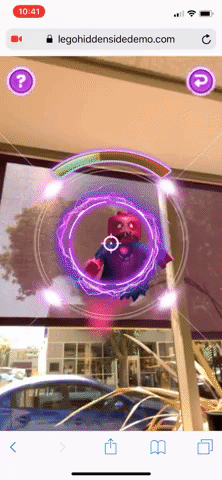
This in-store activation challenged shoppers to go on a ghost hunt and help their LEGO friends, Jack and Parker, capture virtual ghosts who have escaped into the real world and could be found around the store. Shoppers who captured all the ghosts were given access to play with the Hidden Side play set in the demo area of the store as a reward.
https://medium.com/media/388670081c2f8bb10cfb827df95ba9ec/hrefA good experiential campaign can transform an environment into something out of this world and AR can certainly do this in ways that would not be possible with physical sets.
Agencies HappyLucky and 14Four are behind the above WebAR activation which launched exclusively in four Finish Line stores in the USA. As part of adidas’ “Forever the Future” campaign, shoppers scanned signage to activate layers of interactive ”futuristic” content. This type of campaign can dramatically increase dwell time and engagement in-store and encourage users to view product in a brand new manner.
Augmented Reality can also remove the need for dressing up a space entirely, taking a blank space and transforming it into a shopping experience.
https://medium.com/media/31611bcfbbe0c3f0e5d485509309fb0b/hrefWorking alongside marketing agency We Are Social, seeper created an augmented-reality shopping experience for LEGO Wear’s brand new adult clothing line using Snapchat. The Snapchat Lens was launched at a one-day pop-up store in Soho, London as part of London Fashion Week 2019. What seemed like a completely empty store was transformed as shoppers scanned the special Snapcode to reveal the augmented LEGO store. The virtual shop contained interactive animated staff and a link to the real online store where merchandise can be bought.
https://medium.com/media/cf8972106b32e192de843f4b8d8e5edd/hrefAR can also turn a physical location into an experience that must be visited during a limited period of time creating a reason to enter and experience something meaningful indoors. As part of The New Order project with Selfridges created by Visualise, ‘Digital Falls’ was an AR art experience which was installed within the Atrium at the heart of the store in London for a limited run of one month in September of last year.
It can also bring a location and experience to the user no matter where they are. To promote its line of self-tanner products, SOL — Jergens teamed up with agency COFFEE Labs to create an AR portal to paradise. The immersive escape transports the user to their own private island in the sun, where they can explore the dreamy beach and tap on hot spots to learn more about SOL products.
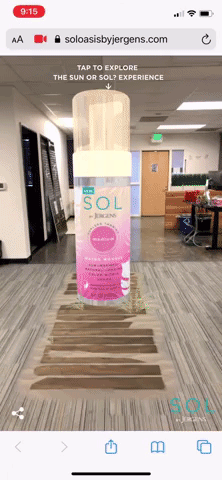
A great example of how VR is evolving experiential marketing is from a startup out of Walmart’s Store №8 called Insperience. Insperience transports the customer to a branded world which creates a new path to purchase and emotional connection to the brand using the medium of VR.
https://medium.com/media/6940a6a539da032d64f31805de9bc365/hrefTheir first example was a collaboration with Dreamworks’ “How to Train Your Dragon”. 16 Walmart locations featured this experience which took the customer into the world of “How to Train Your Dragon” powered by HP VR tech and Voyager motion chairs. After experiencing the 5-minute VR story the customer was immediately taken to the merchandise shop where they could purchase plush toys, action figures, DVDs and more.
The Evolution of Customer Support
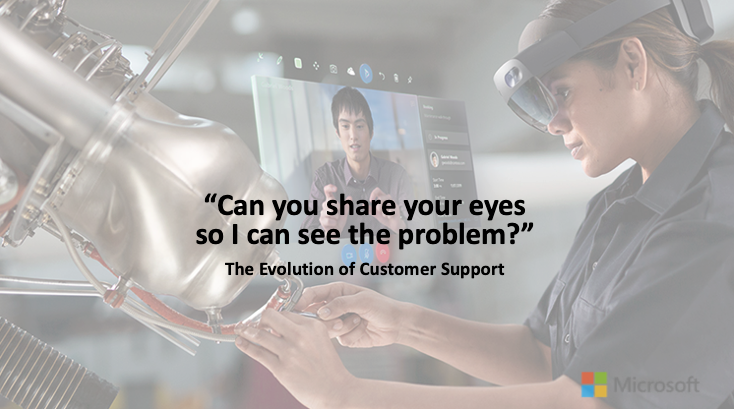
A large part of a brands relationship with a consumer happens after the purchase and the product makes it way to the home. AR and VR is a game changer in customer support. VR simulations and AR instructional overlays will create more intuitive opportunities to educate the user on product use, and guide installation and assembly and remote assistance, telepresence and social VR experiences all provide a way for consumers and brand staff to connect, collaborate and troubleshoot in the same space which saves time, reduces the costs related to travel and dramatically improves customer satisfaction.
https://medium.com/media/760affc2f2f82970aaf9d560250ab87c/hrefA good example of this today is Streem which combines augmented reality, remote video & uses contextualized data to help brands power an exceptional customer experience. With Streem, brands can see what their customers see using the camera on the smartphone which leads to diagnosing and resolving issues quickly and efficiently; guide and assist customers with simple, intuitive tools such as drawing or using cursors to highlight and relay simple instructions; and use computer vision to automatically gather information such as measurements and recognizing parts.
Using AR to do away with the paper manual is also a great example of how AR is evolving customer support. Hyundai, Mercedes-Benz, and Genesis are just a few of the car companies that have all used AR to replace the paper manual and help vehicle owners do anything from get better acclimated with their engines to changing their oil and more.
https://medium.com/media/b8ecc2f9fc66f687840f02c51fcf1217/hrefTelepresence solutions such as Spatial takes customer assistance to the next level. Spatial turns the space around you into a shared augmented workplace. Remote users can collaborate, search, brainstorm and share content as if they were in the same room. Spatial’s avatars allow remote users to “teleport” to the physical space which, through AR headsets like HoloLens or Nreal, allow those physically present in the room to virtually feel face to face. Spatial’s solution is interoperable which means that users can participate using desktop, mobile and AR headsets.
https://medium.com/media/5b1c69df7c22d6f68d59dc64353a7c54/hrefA very similar value proposition is offered in VR. MeetinVR is an online meeting and collaboration solution which allows users to meet in the same virtual reality space.
https://medium.com/media/2825eb198b172cc1932f64aaf25a31bc/hrefBeing in a simulation has its benefits as all users in this space are avatars, virtual customer support staff could be branded and you could also choose to brand the environment. And as the outside world is removed, this setting lends itself to an increase in focus and engagement. In fact MeetinVR boasts a 25% higher attention span in its software compared to traditional video conferencing.
The Evolution of Consumer Insights
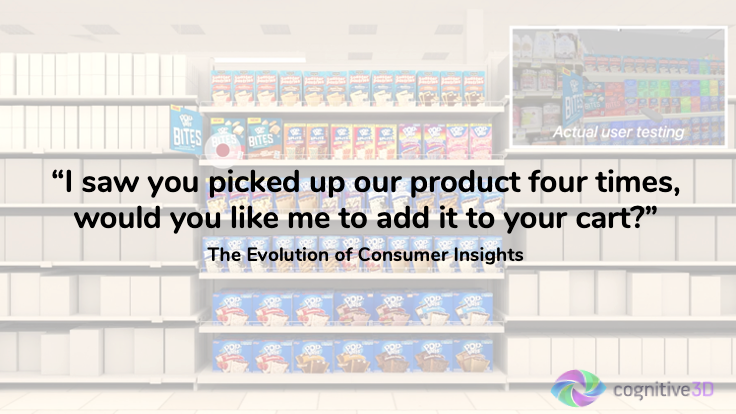
The web made the consumer measurable — offering a ton of data such as views, clicks, conversions, demographics and other online behavior. Mobile took this further by giving us location and with social we understand online relationships. While this data has helped us build and sell better products, it really is just the tip of the iceberg.
AR and VR will unlock a new reservoir of user data, especially once we get to the point where we are wearing a device as part of our everyday. As the computer gains it senses through the user, that same sensor data can be made available to analyze and understand the user. In this way, AR and VR experiences can provide data on what the user sees, what they are interacting with, and even how they might be feeling. While this data presents a massive opportunity, it will require a new set of tools and skills to harness it, ethical and regulatory discussions to govern it including a privacy by design approach which is paramount, and a complete change in business strategy and success measurement to utilize it correctly.
While we are not completely at the point where we can monitor users to this extent. We are already seeing this shift start to happen in pilot programs such as this one powered by leading spatial analytics company Cognitive3D and Accenture.
https://medium.com/media/92692c78dff736da980270cb4dccc253/hrefAccenture used virtual reality to build a merchandising solution for Kellogg for the launch of its new Pop Tart Bites. The solution used a Qualcomm reference headset which was equipped with eye-tracking and had the user immersed in a simulated store environment where they were monitored through the space watching them shop, pick up products and place them in their carts. The data led to an entirely different merchandising conclusion than what was derived by traditional methods. Rather than placing the product on higher shelves, which conventional testing indicated, the VR solution demonstrated the optimal placement was on the lower shelves leading to an increase in brand sales by 18% during testing.
While Cognitive3D’s example is demonstrating what happens when a computer can see what a user is doing in virtual space. Computer vision solutions allow computers to monitor what is happening in the real world. An example of this is demonstrated here from Boston-based startup Affectiva whose technology leverages sensors to monitor a persons voice and face to derive demographics, engagement and their assumed emotional state. The video below is showing Affectiva’s Automotive AI solution, which is able to track multiple people in vehicle, detect head pose and facial expressions to identify levels of drowsiness and distraction and detect expressions of joy, laughter, anger and surprise.
https://medium.com/media/49196364c751aa060d62f8b220d3abd2/hrefWhile technology like Affectiva is not yet widely available, developers are starting to get access to facial data from depth-sensing solutions like the iPhone X True Depth Sensing Kit and more robust biometric sensing such as eye-tracking is quickly becoming a staple feature in head-mounted displays such as the HoloLens 2 and the Vive Pro Eye. In this way, the opportunity to really know your user using AR and VR is closer than you think.
https://medium.com/media/75eb1e33752a89cd0e8bdf85248b31b4/hrefToday we derive customer insights from online behavior — sentiment analysis can be performed on text and insights can be gleaned from hearts, likes and emojis on social posts. This next wave of computing will provide us with new user metrics giving insight into our engagement, feelings and more. Of course as valuable as this new data will be to every industry — a privacy by design approach must be at the center of the collection, storage, access and use of this data.
How to get started with AR and VR
I am sure by now you are energized and ready to get started with AR and VR. But how? Well I’ve put together a 10 step list to take back to your teams to kick start your efforts
- Define Your Campaign Goals
The first is define the goals of your campaign — are you looking to raise brand awareness, create social buzz, or convert users to purchase? Having a clear goal in mind will help you not only assess what platforms are a good fit for your campaign but most importantly this will lead you to create an AR and VR campaign which can demonstrate ROI when it is complete.
2. Keep the user at the center of all decisions
Next think about your user. Who is your user? And what devices will they have access to at the time of the campaign? And where do you expect them to experience it?
3. Ask how AR and VR can deliver value
With your goal and user in mind, ask yourself how AR and VR can deliver value. What is it that these technologies can bring to the campaign that other mediums cannot achieve?
4. Select the platform that can best deliver your goals
Once it is clear how AR and VR can be used by your target audience to achieve your goals, it is now time to identify the right platform. If reach and ease of access is a priority for this campaign then mobile WebAR — with nearly 3 Billion smartphones supported and no app to download may be the right fit.
5. Work with best-in-class partners
Picking the right platform will narrow down the partners to work with to make the campaign a reality.
6. Think in 3D
With tools in your teams hand, it is time to think 3D. Now is the time to be hyper-obsessed with the experience and to create a campaign that leverages the unique offerings of this next wave of computing.
7. Remember that AR and VR is part of the marketing mix
All that being said, remember that AR and VR is part of your marketing mix. Just as much as have thought through the AR experience, you need to think about how your user will discover what you have created.
8. Measure, measure, measure
When your campaign is live measure its performance against your goals
9. Listen and learn to level up your campaign
And listen and learn from your users and their experience to level up your next campaign
10. Repeat
Finally keep going! We are all just getting started with AR and VR and this technology is here to stay. The more projects you undertake the more your team will be ramped up to thrive in this space.
Good luck! I can’t wait to see what you create!
Learn more about how you can get started with the 8th Wall platform at www.8thwall.com. Want to chat AR or VR? Email me at tom@8thwall.com.
Advertising Enters the Next Dimension was originally published in 8th Wall on Medium, where people are continuing the conversation by highlighting and responding to this story.



Adverts completely ruin my internet browsing experience. Therefore they will also run the VR experience for me too.